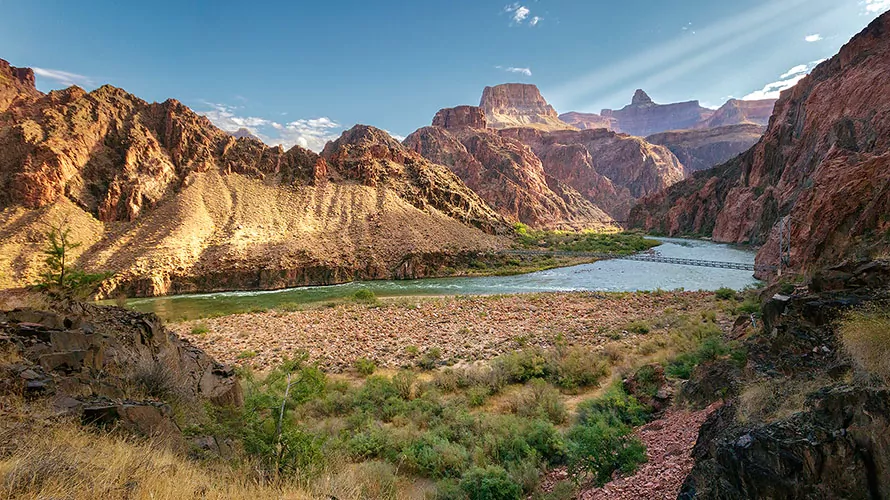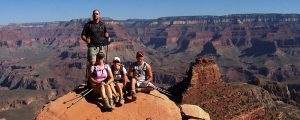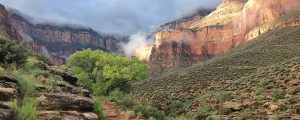Phantom Ranch Tour
Inn-Based Hiking Tours
2-3 Days, 1-2 Nights
17MI / 27KM

Description
Fantastic for families, small groups, or solo travelers, this Grand Canyon hike is a classic choice. Our Phantom Ranch hiking tour combines great hiking, phenomenal views, two nights at historic Phantom Ranch (can cool off in summer, warm up in winter), and time to explore the bottom of the Canyon. We spend 2 nights on many tours, allowing us to day hike and explore the bottom of the Canyon on Day 2. Some tour dates feature one night trips. Either way, this classic Grand Canyon trip does not disappoint!
You’ll hike down the famous South Kaibab trail to Phantom Ranch (carrying your clothing and personal items), where you’ll spend two nights. We include a layover day to go on a day hike led by your guide, simply relax, and/or enjoy interpretive talks at Phantom Ranch. On the last day you’ll hike back to the South Rim via the Bright Angel Trail, hiking past Havasupai Gardens (a desert oasis where Native Americans planted crops for centuries) along the way. Give us a call at 1-800-715-HIKE (4453) for more information or to begin the process of creating a trip!
Trip Details
-
Trip Type
Inn-Based Hiking Tours -
Trip Length
2-3 Days, 1-2 Nights -
Daily Hiking Distance
Up to 9.5 mi -
Group Size
4-9 Guests
What's Included
-
1-2 nights of lodging in the dorms at historic Phantom Ranch
-
Dinners and breakfasts at Phantom Ranch, lunches prepared by your guide
-
Use of a day pack, trekking poles and Microspike crampons during winter months
-
Trained hiking guide(s) with years of personal wilderness and hiking experience, medical certifications, and a passion for leading people into breathtaking landscapes. See Guide Bios.
-
Emergency equipment including a company-issued first-aid kit and communication device
-
Mandatory 5% national park fee that passes through directly to Grand Canyon
What's Not Included
-
Clothes, raingear, and footwear
-
National park entrance fee
-
Sunscreen, toiletries and personal items
-
Water bottles and a headlamp or flashlight
-
Alcoholic beverages
-
Guide gratuity (industry recommendation is 10-20% of trip cost)
Day 1

Shuttle to the South Kaibab TH: 15 minutes
Hiking Mileage: 7.5 miles
Elevation Loss: 4,800 feet
Accommodations: Phantom Ranch Lodge
This famous Grand Canyon hiking tour begins on the South Kaibab Trail, a popular hiking route that offers spectacular views both up and down the Grand Canyon. It’s seven miles of well-maintained hiking to Phantom Ranch. The scene surrounding the Ranch is one of the most charming in the Park as it’s situated at the bottom of the Grand Canyon near the Colorado River and adjacent to Bright Angel Creek. The stream-side setting makes for a true oasis in the desert.
Day 2 (3-day Itinerary Only)

Hiking Mileage: 0-7 miles day hiking
Elevation Gain/Loss: < 1,000 feet
Accommodations: Phantom Ranch Lodge
This is a layover day and a chance to relax and absorb the magic of the Canyon or go on a memorable day hike. Remember your swimsuit for a soak in the cool waters of Bright Angel Creek, catch up on that book you’ve been wanting to read, spend quality time with your family exploring the area, or join your guide for a customized day hike. Hiking options include an off-trail trek up a side canyon with cascades, pools and oases; a breathtaking hike paralleling the Colorado River a thousand feet above it on the Clear Creek Trail; or a relaxing walk on the River Trail.
Important: this trip is operated as either a 2-day or 3-day itinerary, and is confirmed as such in advance. Variation of trip length does not mean guests can choose to leave a trip or early or extend it a day.
Final Day
Hiking Mileage: 9.3 miles
Elevation Gain: 4,500 feet
Today we’ll pack up and make an early departure for the South Rim. Hiking on the Bright Angel Trail along the Colorado we’ll arrive at Pipe Creek after a couple miles. From here we’ll continue our hike up Pipe Creek to Garden Creek and Havasupai Gardens – a spring that watered seasonal Havasupai garden plots for centuries. From Havasupai Garden it’s a 4.5 mile hike to the South Rim, where we’ll look back over our route and contemplate this once-in-a-lifetime Grand Canyon adventure.
Itinerary Note
Please Note: We always do everything in our power to follow the set itinerary, however it can change occasionally based on temporary access restrictions, weather, lodging/campground availability, guest ability/injury, natural events like fires and flooding, and other potential causes. Normal terms and conditions apply to trips with itinerary changes.
Packing List

IMPORTANCE OF BEING PREPARED
Your safety and enjoyment will depend on your level of preparedness. It is your responsibility to arrive with the items listed below. Our Gear Guide is a resource to find more information about these items and links to online options. If you have additional questions about what to pack, please ask your guide during the pre-trip contact (~10 days prior to the trip start date) or call our Adventure Consultants 7 days a week at 928-223-HIKE (4453).
Packing List Video
For more guidance on the packing list, we recommend watching our Wildland Packing List Video. A senior Wildland guide and outdoor retail expert walks us through each item with examples and insights. Click here to see the video.
STANDARD CLOTHING CHECKLIST
The following items are required for your trip unless otherwise noted. When packing, think layered clothing systems that work together and can be easily added or removed.
STANDARD CLOTHING CHECKLIST
(GG) Gear Guide: see for more info and links to product options
Supportive, lightweight, well-drained shoe or sport sandal for creek crossings and/or for camp comfort (Camp Shoes GG)
One pair for every two days of your trip, plus an extra pair to sleep in. Hiking-specific padded socks, no cotton please! (Socks GG)
( Note: wearing thin liner socks under your hiking socks can help prevent blisters )
Wide-brimmed hat or baseball cap/bandana combo (Sun Hats GG)
2 short and/or long sleeve cotton t-shirts.
( Note: April-October only. Cotton retains moisture and helps to cool the body down in hot, arid desert environments. Cotton shirts are critical garments in terms of safety and comfort in the hotter months. )
1 non-cotton, breathable long-sleeve shirt (Hiking Shirts GG – Sun Hoodie GG) (Note: long-sleeve shirts provide better sun protection)
Mid-weight sweater or pullover of wicking material such as merino wool, fleece or polypropylene (Mid Layers GG)
Nylon pants AND shorts, zip-offs or leggings (Shorts GG – Pants GG)
Waterproof jacket, breathable fabric such as Gore-Tex® or coated nylon. (Rain Jackets GG)
ADDITIONAL CLOTHING (OCTOBER TO APRIL)
Lightweight beanie and light-to-mid weight fleece or wool gloves (Hat/Gloves GG)
Down-fill or synthetic-fill insulated “puffy” jacket or warm, heavy-weight fleece jacket (Mid Layers GG)
1 pair of wicking tops and bottoms that are lightweight to midweight, synthetic wicking materials such as polyester, polypropylene, merino wool…etc. (Base Layers GG)
waterproof pants, breathable fabric such as Gore-Tex® or coated nylon. Look for side zippers that will allow you to pull them over your boots. (Rain Pants GG)
Important Note
Important Note : Please, no cotton hiking clothes with the exception of the “Cotton T-shirts” section above (which are important!) Feel free to call us if you have any questions or you can reference our Gear Guide .
GEAR CHECKLIST
3+ liters capacity, either water bottles or bladder/hose system and an additional water bottle (Hydration Bladders GG) (Note: We recommend always having a bottle with 1 liter of capacity as a back-up in case of a hydration system failure and to use while in camp)
Preferably with an L.E.D. bulb that works with AA or AAA batteries (Headlamp GG)
( Note: always test your headlamp before trips, travel/pack without batteries in device, and for longer trips (4+ days) consider a spare bulb and 1 set of spare batteries )
if you wear contact lenses, please also bring a pair of glasses – your contacts are likely to become dirty and may be difficult to clean
please inform your trip leader of any medications you are taking
small amounts, travel sizes and/or just what you need for the trip (important that they are small!)
for any shopping you would like to do and for consideration of tipping your guide
( Note: industry tipping recommendation is 10-20% of the trip cost based on your level of satisfaction )
OPTIONAL ITEMS
As a Wildland guest, you can enjoy a 20% discount off Leki trekking poles (reservation number required.) Click here for discount. Trekking poles are provided for guests who do not bring their own. (Trekking Poles GG)
only if swimming is an option on your trip, some guests prefer to swim in quick drying hiking clothes, sports bra, etc…
various sizes for better organization of clothing & gear, and/or to help create a camp pillow, etc.
( Note: A lightweight waterproof stuff sack can be extremely useful in wet conditions )
consider bringing any joint braces that may be currently needed or from past injuries (i.e. knee, ankle, elbow, etc…)
lightweight paperback book, magazine or small notebook/pen for journaling
for camera, headlamp or other electronics
Small, lightweight devices to recharge electronics (Power Bank GG)
lightweight, compressible and packable – bandanas also work (Camp Towel GG)
DO NOT Bring
– per our terms and conditions no firearms or other weapons are permitted, including knives with blades longer than 4 inches
– including marijuana, which is illegal on federal lands and in national parks
TRAINING
Training is extremely important for you to maximize your enjoyment! The more physically prepared you are, the more fun you’ll have! Click below to read our training recommendations.
TRAVEL, TRANSPORTATION, MEETING & LODGING

MEETING TIME & PLACE
Unless we tell you otherwise, you will meet your guide and group in the lobby of the Bright Angel Lodge at the South Rim of the Grand Canyon at 5:00 PM the evening before your trip begins. For Private Phantom Ranch Tours your guide can meet you at your hotel in Tusayan or at the South Rim at an agreed upon time.
TRIP CONCLUSION
This trip will conclude at approximately 5:00 PM on the last day.
ARRIVAL & DEPARTURE DATES
Travel to and from the trip starting point is not included in the cost of our trips. Please plan on arriving in time for the orientation meeting the day before the trip leaves and departing the day after getting back from the field.
GATEWAY CITIES:
Phoenix or Flagstaff, Arizona
SHUTTLE FROM PHOENIX/Flagstaff TO The South Rim
TRANSPORTATION TO & FROM THE TRAILHEAD
We utilize national park transportation from the South Rim Village to our starting trailhead. Our ending trailhead is at the South Rim Village.
STORAGE OF PERSONAL ITEMS & VEHICLES
The best place to store your luggage and vehicle is at your hotel.
PRE & POST-TRIP LODGING
National Park Lodges
Website / 1-888-29-PARKS (888-297-2757)
Grand Canyon Squire Inn (Tusayan, AZ)
Website / Phone: 928-638-2681
Grand Hotel (Tusayan, AZ)
Website / Phone: 928-638-3333
Trip Insurance
We strongly recommend purchasing trip insurance. We designed our terms and conditions with trip insurance in mind. When you register for a trip, your spot is no longer available to other guests. Therefore, if you discover that you are unable to travel, no refund is available past a certain point. With trip insurance, your payment to Wildland may be covered, but also your flights, hotels and other travel costs can also be insured.
Read more about our trip insurance recommendations.
Pack Weight & Contents

You will be hiking with a day pack that we provide. You’re also welcome to bring your own. The contents will be what you need for the trip – clothing, extra layer(s), rain jacket, water, snacks, personal items…etc.
ESTIMATED PACK WEIGHT: 15-25 POUNDS
Check The Weather Forecast For Your Trip
We recommend using NOAA’s website (www.weather.gov) for the most accurate 5-day weather forecasts. There are two elevations to check when looking at Grand Canyon weather forecasts:
The weather in the Grand Canyon varies tremendously from the rim to the canyon floor, with as much as a 30 degree Fahrenheit difference. For this reason, the Canyon is truly a year-round hiking destination. To be fully prepared, please follow the recommended clothing list closely (this list comes as part of your trip packet when you register). Read below for average high and low temperatures at the South Rim and the Canyon bottom:
| AverageTemperatures(Fahrenheit)
|
||||||||||||||||||||||||||||||||||||||||||||||||||||||||
Guide Shifts

Guides are required to take 10-12 hours off each 24-hour period to sleep, recuperate, take personal time, take rest breaks…etc. and be uninterrupted for a minimum of 8 hours each night. We ask guests to respect these requirements and to not interrupt guides’ off time and sleep time unless there is a true emergency.
Tipping Your Guide
Tipping your guide is greatly appreciated! Wildland guides, and outdoor/backcountry guides in general, do much more than lead guests down the trail. Although supported by amazing in-town staff, they often work independently in the field due to permit and logistical constraints. The guide is responsible for the group’s safety, menu planning (including dietary restrictions), cooking for the group, prepping and taking care of the gear, handling livestock (on stock-supported trips), driving, complying with government regulations, ensuring guest satisfaction, and generally making sure the tour runs smoothly. They wear many hats and are extraordinary at what they do!
The industry standard tip amount for hiking and backpacking guides is between 10% and 20% of the tour cost per person, depending on your level of satisfaction. If you have any questions about tipping, feel free to call us 7 days a week at 800-715-HIKE (4453)!
Group Travel
Please take the time to clearly understand the trip you’re registering for, and select a tour that matches your ability level.
It is possible there will be a discrepancy in fitness levels on your trip. Consider that the trip may be a once in a lifetime opportunity for your fellow travelers and it is important to respect each guest’s individual condition, needs and desires.
Finally, guided groups are required by land management agencies to stay together on the trail. Hiking together can require patience and flexibility. If hiking at a very specific pace is extremely important to you, you may want to consider booking a private trip.
Grand Canyon Conservancy
 By traveling on this trip, you’ll directly support our Intrepid Foundation partner, the Grand Canyon Conservancy. Donations help them protect Grand Canyon National Park and support trail restoration, conservation of native plants and wildlife, and educational programs. Learn more about this partnership!
By traveling on this trip, you’ll directly support our Intrepid Foundation partner, the Grand Canyon Conservancy. Donations help them protect Grand Canyon National Park and support trail restoration, conservation of native plants and wildlife, and educational programs. Learn more about this partnership!
Local Maps
Grand Canyon National Park requires guide companies to provide every guest access to a map of the area(s) we’ll be hiking. You’ll find the map link(s) below. If you’d like, you can download and print or download to your phone for access during the trip. Your guide will also have a high quality, detailed, waterproof topographical map that you can reference out on the trail.
Essential Eligibility Criteria
Essential Eligibility Criteria (“EEC”) have been specifically identified to help you understand the skills and abilities necessary to participate on each Wildland trip, and they apply uniformly to all potential trip participants, irrespective of the presence or absence of any disability.
Once you identify a trip in which you may be interested, please carefully review the EEC and itinerary details. If after reviewing the EEC that apply to your desired trip, you determine you need an accommodation in order to meet the EEC, please contact us prior to registering to discuss your requested accommodation.
The EEC exist for your own safety and the safety and enjoyment of all participants. If you are unable to meet the EEC for the trip, with or without an accommodation, you are not eligible for that trip. If you register and arrive for a trip for which you do not meet the EEC, you will be disqualified from participation on the trip and will be dismissed or evacuated from the trip without a refund.


